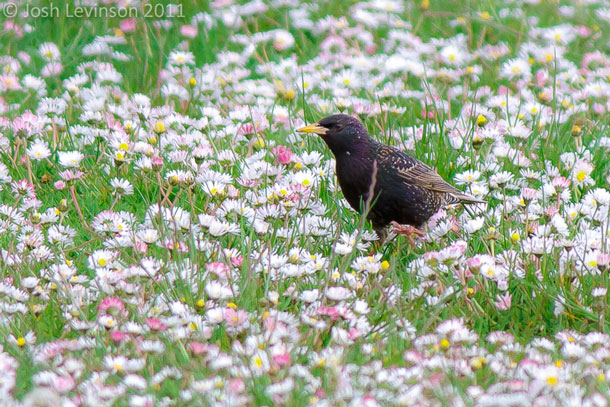BirdNote®: Starlings Say It With Flowers
Air Date: Week of October 12, 2018

The European Starling is thought to adorn its nest with flowers to ward off pests. (Photo: Josh Levinson)
European Starlings can often be found scrounging through the grass of a backyard or a nearby park for tasty treats. But now and then, they’ll also pluck a marigold or other bright flower to bring back to the nest. These flowers aren't just for decoration, as Michael Stein explains in this week’s BirdNote. It appears to bring health benefits to their young.
Transcript
CURWOOD: It’s Living on Earth. I’m Steve Curwood.
[MUSIC: BIRDNOTE THEME]
CURWOOD: European Starlings famously travel in massive flocks, up to one hundred thousand birds strong at times. They can almost resemble a school of fish moving together in a squeaky symphony. And, Bird Note’s Michael Stein reports that when starlings are paired up and raising chicks they have an unusual way to keep their nest clean and healthy.
STEIN: European Starlings are a common sight in suburban yards, waddling methodically through the grass to dig for grubs and other tasty bits. Watch long enough, though, and you may see a starling pause in the hunt to neatly pluck a marigold or other bright flower – and then fly up to deposit the bloom in the nest.
How romantic. But there’s more to it. Ornithologists have found that starlings regularly adorn their twig nests with fresh vegetation – the more fragrant the better. Marigolds, of course, but also elderberry flowers, yarrow leaves, and even willow bark.
All of which – as your nose will tell you – are full of aromatic chemicals. The starlings are actually fumigating their nests. Why? The chemicals have been thought to help discourage pests and parasites. Scientists have discovered that the smelly plants may offer an even more direct benefit to nestlings – by stimulating their immune systems.
It turns out that starlings hatched in well-fumigated nests tend to weigh more and live longer than those raised without benefit of fragrant herbs.
The gift of flowers: romantic and practical all at once. I’m Michael Stein.
Written by Rick Wright
Bird sounds provided by The Macaulay Library of Natural Sounds at the Cornell Lab of Ornithology, Ithaca, New York. European Starling [206992] by Greg Budney.
BirdNote's theme music was composed and played by Nancy Rumbel and John Kessler.
Producer: John Kessler
Managing Producer: Jason Saul
Associate Producer: Ellen Blackstone
European Starling in flowers © Josh Levinson facebook.com/JoshLevinsonPhotography/
© 2005-2018 Tune In to Nature.org October 2018 Narrator: Michael Stein
https://www.birdnote.org/show/starlings-say-it-flowers
CURWOOD: For photos, flock on over to our website loe.org
Links
Living on Earth wants to hear from you!
Living on Earth
62 Calef Highway, Suite 212
Lee, NH 03861
Telephone: 617-287-4121
E-mail: comments@loe.org
Newsletter [Click here]
Donate to Living on Earth!
Living on Earth is an independent media program and relies entirely on contributions from listeners and institutions supporting public service. Please donate now to preserve an independent environmental voice.
NewsletterLiving on Earth offers a weekly delivery of the show's rundown to your mailbox. Sign up for our newsletter today!
 Sailors For The Sea: Be the change you want to sea.
Sailors For The Sea: Be the change you want to sea.
 The Grantham Foundation for the Protection of the Environment: Committed to protecting and improving the health of the global environment.
The Grantham Foundation for the Protection of the Environment: Committed to protecting and improving the health of the global environment.
 Contribute to Living on Earth and receive, as our gift to you, an archival print of one of Mark Seth Lender's extraordinary wildlife photographs. Follow the link to see Mark's current collection of photographs.
Contribute to Living on Earth and receive, as our gift to you, an archival print of one of Mark Seth Lender's extraordinary wildlife photographs. Follow the link to see Mark's current collection of photographs.
 Buy a signed copy of Mark Seth Lender's book Smeagull the Seagull & support Living on Earth
Buy a signed copy of Mark Seth Lender's book Smeagull the Seagull & support Living on Earth

